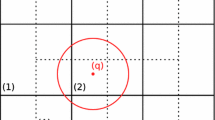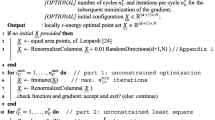Abstract
In this paper we propose an unstructured hybrid tessellation of a scattered point set that minimally covers the proximal space around each point. The mesh is automatically obtained in a bounded period of time by transforming an initial Delaunay tessellation. Novel types of polygonal interpolants are used for interpolation applications and the geometric qualities of the elements make them also useful for discretization schemes. The approach proves to be superior to classical Delaunay one in a finite element context.
Similar content being viewed by others
References
Aurenhammer F, Klein R (2000) Voronoi diagrams. Handb Comput Geom 5: 201–290
Belikov V, Ivanov V, Kontorovich V, Korytnik S, Semenov A (1997) The Non-Sibsonian interpolation: a new method of interpolation of the values of a function on an arbitrary set of points. Comput Math Math Phys 37(1): 9–15
Calvo N, Idelsohn SR, Onate E (2003) The extended Delaunay tessellation. Eng Comput 20(5/6): 583–600
Chen JS, Wu CT, Yoon S, You Y (2001) A stabilized conforming nodal integration for galerkin mesh-free methods. Int J Numer Methods Eng 50: 435–466
Delaunay B (1934) Sur la sphére vide. A la memoire de Georges Voronoi. Izv Akad Nauk SSSR, Otdelenie Matematicheskih i Estestvennyh Nauk 7: 793–800
Descartes R (1644) La disposition de la matiere dans le systeme solaire et ses environs
Dirichlet GL (1850) Über die Reduktion der positiven quadratischen Formen mit drei unbestimmten ganzen Zahlen. Journal für die Reine und Angewandte Mathematik 40: 209–227
Dyken C, Floater MS (2006) Preferred directions for resolving the non-uniqueness of delaunay triangulations. Comput Geom Theory Appl 43: 96–101
Floater M (2003) Mean value coordinates. Comput Aided Geom Des 20: 19–27
Franke R, Nielson G (1980) Smooth interpolation of large sets of scattered data. J Numer Methods Eng 15: 1691–1704
Lawson CL (1977) Software for c 1 surface interpolation. Mathematical Software III pp 161–194
Sambridge M, Braun J, McQueen H (1995) Geophysical parameterization and interpolation of irregular data using natural neighbors. Geophys J Int 122: 837–857
Shewchuk JR (1999) Lecture notes on Delaunay mesh generation. Department of Electrical Engineering and Computer Science, University of California at Berkeley
Shewchuk JR (2002) What is a good linear element? Interpolation, conditioning, and quality measures. Proceedings, 11th International Meshing Roundtable, pp 115–126
Sibson R (1978) A vector identity for the dirichlet tessellation. Comput J 21: 243–245
Sibson R (1981) A brief description of natural neighbor interpolation. In: Barnett V (eds) Interpreting multivariate data. Wiley, NY, pp 21–36
Sukumar N (1998) The natural element method in solid mechanics, Ph.D. Thesis, Theoretical and applied mechanics, Northwestern University
Sukumar N, Malsch E (2006) Recent advances in the construction of polygonal finite element interpolants. Arch Comput Methods Eng 13: 129–163
Sukumar N, Tabarraei A (2004) Conforming polygonal finite elements. Int J Numer Methods Eng 61: 2045–2066
Voronoi G (1908) Nouvelles applications des paramétres continus á la théorie des formes quadratiques. Journal für die Reine und Angewandte Mathematik 133: 97–178
Warren J, Schaefer S, Hirani A, Desbrun M (2003) Barycentric coordinates for convex sets. Tech. rep. Rice University, Houston
Watson DF (1981) Computing the n-dimensional Delaunay tessellation with application to Voronoi polytopes. Comput J 24(2): 167–172
Author information
Authors and Affiliations
Corresponding author
Rights and permissions
About this article
Cite this article
Constantiniu, A., Steinmann, P., Bobach, T. et al. The Adaptive Delaunay Tessellation: a neighborhood covering meshing technique. Comput Mech 42, 655–669 (2008). https://doi.org/10.1007/s00466-008-0265-3
Received:
Accepted:
Published:
Issue Date:
DOI: https://doi.org/10.1007/s00466-008-0265-3




